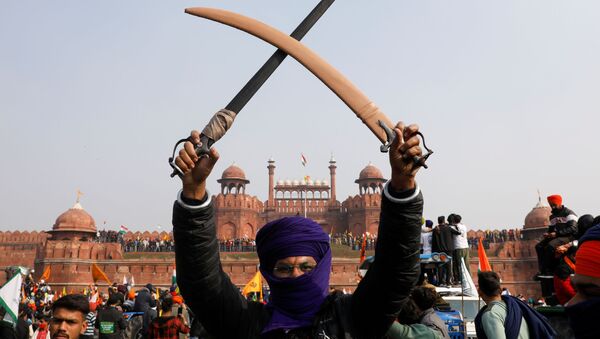Thousands of farmers, who have been protesting against three newly passed farm laws since November 2020, crossed the borders to enter the national capital on Tuesday. The Delhi Police, which had allowed the farmers to carry out their proposed tractor rally between 12:00 pm to 5:00 pm (IST) in the city, ended up using tear gas and batons against the farmers to stop them from violating the agreed upon rules in the morning.
The time and the routes for the tractor rally were finalised after several rounds of meetings. But farmers drove tractors off the routes and before the fixed time, leading to vandalism in which many police personnel were injured: Delhi Police Commissioner SN Shrivastava to ANI pic.twitter.com/Db8zTayCCS
— ANI (@ANI) January 26, 2021
How the Riots Transpired Over the Day in Delhi
Soon, visuals from Delhi's borders began surfacing on social media, showing masses of people running, some on horseback, tussling with police forces and trying to enter the capital.
#WATCH Protestors at Karnal bypass break police barricading to enter Delhi as farmers tractor rally is underway in the national capital#FarmLaws pic.twitter.com/pzfJs6Ioef
— ANI (@ANI) January 26, 2021
By noon, reports of violent clashes between cops and protesters began pouring in from different areas of Delhi. Nangloi Chowk, Akshardham, and the ITO – where the Delhi Police Headquarter is located – emerged as the hotspots of riots in the city.
#Verified
— Saahil Murli Menghani (@saahilmenghani) January 26, 2021
👉Unbelievable scenes here in Delhi just a KM away from Akshardham
👉Close to 20000 MORE tracrors are trying to enter further into Delhi
👉Police is firing 15-20 tear gas shells per minute
👉One of him hit this tractor & then this happened
👉I'll keep reporting 👇 pic.twitter.com/gh24YXTDr1
Especially in the ITO area, police officials were caught on camera throwing tear gas shells at hundreds of farmers, who were wielding sticks and clubs. The area, located just a few kilometres away from parliament, was chosen by the farmers as a route towards Rajpath.
Protesters attack Delhi Police personnel, vandalize buses and break barricades at ITO, New Delhi. Protest loses all meaning once you resort to violence and rioting. Masses won’t support any cause where protest leads to physical attack on police personnel. pic.twitter.com/3BZz1T9QMG
— Aditya Raj Kaul (@AdityaRajKaul) January 26, 2021
A person was reported dead in Delhi’s DDU Marg area after a tractor overturned during the violence.
REPORTS: 1 farmer dead after tractor overturned at Delhi's DDU Marg during violent clashes between Delhi police and #Farmers #KisanTractorRally https://t.co/dmh9MOXNSL
— Milan Sharma (@Milan_reports) January 26, 2021
Just as the situation became even tenser, shocking news of protesters invading Delhi’s symbolic Red Fort to hoist another individual “Kesari” (yellowish coloured) flag alongside the national Tricolour began breaking on the Internet. The flag that the protesters hoisted at the Red Fort is called the “Nishan Sahib Flag” and is considered sacred in Sikhism.
#RedFort #Delhi
— Radhika Parashar (@_RadhikaReports) January 26, 2021
26/1/2021 pic.twitter.com/2rWqzAgrjY
Protesters tie ropes to the gate to bring it down. pic.twitter.com/rT7aHgO1t6
— Advitya (@advityabahl) January 26, 2021
Protesters have captured the iconic Red Fort#TractorRally #HistoricTractorMarch #26JanDelhiChalo #TractorsVsTraitors #FarmersProtest pic.twitter.com/cwZopaJw42
— Advitya (@advityabahl) January 26, 2021
Farmers have reached the iconic Red Fort. They can been seen playing loud music and dancing.#HistoricTractorMarch#FarmersProstests#TractorRally @SputnikInt pic.twitter.com/KhdzrDDCCG
— Advitya (@advityabahl) January 26, 2021
Several farmer leaders have, however, said that some notorious miscreants, probably related to “political groups”, had infiltrated the gatherings of protesters and the triggered violence.
"We are conducting the rally peacefully. We know that some political elements want to disrupt the rally": Rakesh Tikait, Farmer Leader #FarmersProtest pic.twitter.com/8WtLxeISEo
— NDTV (@ndtv) January 26, 2021
Government’s Response
Taking into consideration Delhi’s tense situation, federal Home Minister Amit Shah called for an emergency meeting with counterparts from the governing Bharatiya Janata Party (BJP) to discuss the next line of action.
In a bid to bring the protesters under control before the situation escalates, the Home Ministry has ordered the deployment of over 1,500 more troops across the capital, including personnel from paramilitary forces. Delhi was otherwise being guarded by over 7,000 troops, but the protesters outnumbered them by thousands.
In addition, netizens also discussed the Internet and telecom services being disrupted or cut in several parts of Delhi.
Order given to all telcos in Delhi-NCR to switch off internet in border areas and give only 2G in other parts. Shutdown happening in phases. #InternetShutdown
— D (@DanishKh4n) January 26, 2021
Internet services suspended in some parts of NCR @CNNnews18 pic.twitter.com/3xnyIlOMkO
— Marya Shakil (@maryashakil) January 26, 2021
Internet services suspended in many parts of Delhi.
— Tractor2ਟਵਿੱਟਰ (@Tractor2twitr) January 26, 2021
Is this to suppress the correct information and allow #GodiMedia to run propaganda?#HistoricTractorMarch #Tractor2Twitter pic.twitter.com/jFD8cKONIx
The agitating farmers, who demand that three farm laws passed during the monsoon session are revoked by the government, are firm in their stance.
The three laws that sparked the controversy are the Farmers’ Produce Trade and Commerce (Promotion and Facilitation) Act, 2020, the Farmers (Empowerment and Protection) Agreement on Price Assurance and Farm Services Act, 2020, and the Essential Commodities (Amendment) Act 2020.
The farmers fear that with these new laws, the BJP government is backing out from its role as a price guarantor for their produce while leaving their earnings to be influenced by market forces.
The government, led by Prime Minister Narendra Modi, has, however, called the laws “progressive”.
After over 10 rounds of discussions between the farmers and government officials, no solution has been reached as of now.








